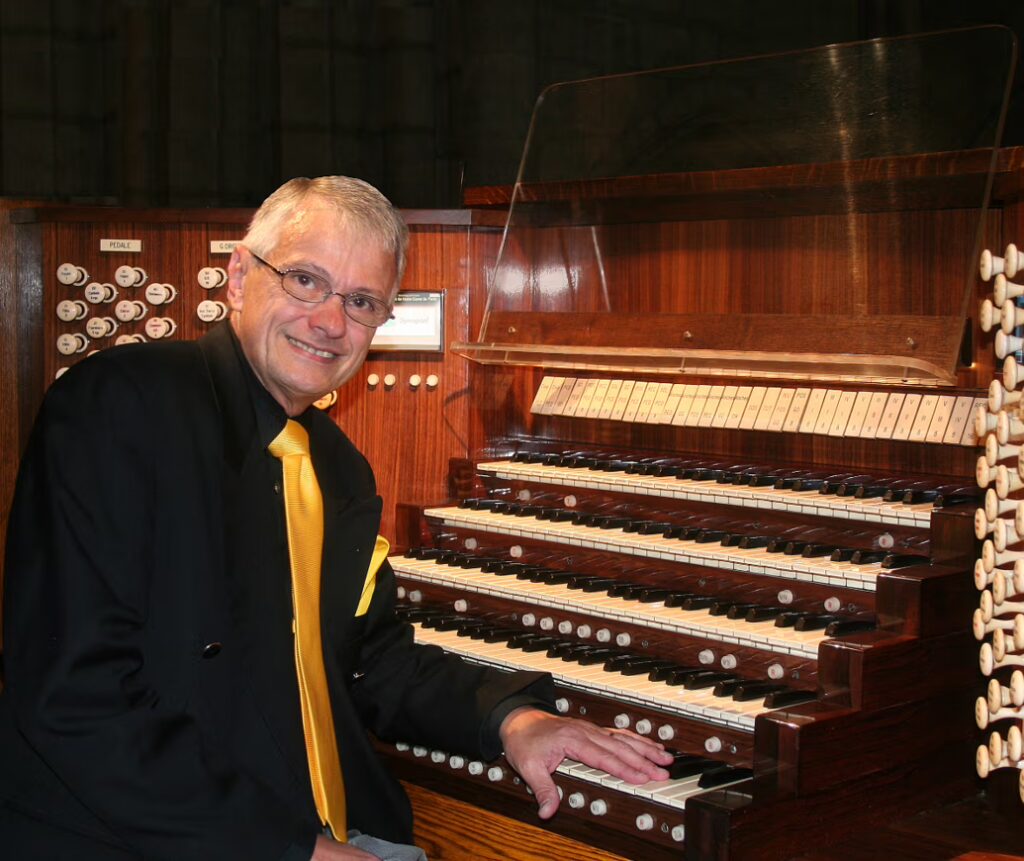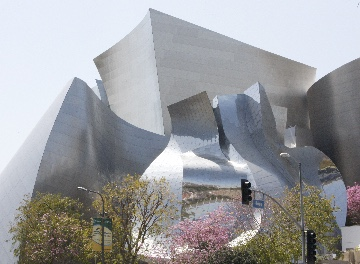
The great Argentinian organist Hector Olivera may be pushing 80, but he was like a kid in a candy store during his organ recital at Walt Disney Concert Hall on Sunday evening. He performed a variety of works either written explicitly for or arranged for the organ — but the entertainment went beyond the music. Olivera is a showman and engages with the audience in ways that endear him to them. He is physically expressive and funny, and, by the way, he has a little green (stuffed animal) frog that sits on the organ while he plays. He even talked to it!
Organ concerts at Disney Hall always attract a unique audience. For one, there are always more organists in the audience than usual. But, perhaps more importantly, there are people who come out to hear the great Disney Hall organ and who are loyal fans of the particular organists who come to town. Each individual organist has his or her own playing style and performance style. Olivera is no exception.
Olivera combined great playing with personal charm and humor that held the audience’s rapt attention for more than an hour and a half on Sunday night. And he did all that with the energy and stamina of someone much younger. It was downright infectious!
More than once Olivera proclaimed that in general he approaches playing the organ, and in particular the Disney Hall organ, as an orchestra. His love affair with the Disney Hall organ is in part because of the extensive orchestral capabilities endowed by organ builder Manuel Rosales, whose name Olivera invoked reverentially more than once during the evening.
Olivera’s orchestral approach to playing was evident from the outset in the first piece on the program: the Coronation March from Le prophète by Meyerbeer, arranged by Olivera. What a way to open an organ concert! The march was originally written for orchestra, but he played it in orchestral fashion on the organ. If anyone needed to be awakened, his performance certainly did it.
From then on out, Olivera introduced each piece with a combination of wit and humor befitting a comedian. But the next piece was anything but humorous. It was Passacaglia and Fugue in C minor BWV 582 by Bach, one of the greatest masterpieces ever composed for any instrument at any time, a point acknowledged by Olivera. But, he told the audience, he wasn’t sure he had permission to play it the way he was going to, taking advantage of the full orchestral potential of the organ. It was a tour de force performance of a masterpiece that few, if anyone, had heard played quite that way before.
Olivera next performed his arrangement of fellow Argentinian Astor Piazzolla’s Oblivion, from the Italian movie Henry IV. The piece combines the counterpoint of Bach with the tango, and once again Olivera used the Disney Hall organ to great effect in conveying the sadness of the piece.
Olivera finished the first half with the last piece that Cesar Franck composed, the Chorale No. 3 in A minor for organ. Olivera talked about how when he was a kid there was a set of pictures in a frame over his bed including Bach. One of the pictures was of a composer he did not know at the time. Of course, later he discovered it was the great French composer Franck. Franck was first and foremost an organist, and one can hear that influence in his orchestral works, in particular in his great Symphony in D minor. But he also composed many works for the organ, including this Chorale, which features melodic lines, dissonances and dramatic dynamic swings. Olivera threw himself into the performance and pulled out all the stops — literally and figuratively — bringing the audience to their feet.
The second half consisted of four works. The first was a rapid scherzo by Italian organist and composer Marco Enrico Bossi. One could only marvel at the speed with which Olivera’s fingers moved across the keys and the four keyboards, all the while, as with the other pieces on the program, turning pages and pulling out stops.
The last two programmed works were the Bohemian Rhapsody by Freddie Mercury of Queen and A Whiter Shade of Pale originally composed and performed by the English rock band Procol Harum. Olivera’s transcription of Bohemian Rhapsody maintained the recognizable melodies of the original song but placed them in the context of a more classical structure.
Olivera first heard A Whiter Shade of Pale on a transistor radio when he was working the night shift as a mail clerk at a local business while attending the Juilliard School in the mid 1960s. According to Olivera, “That song is my heart.” The reason is because the beginning of the song is based on Bach’s Air on the G string from the Orchestral Suite No. 3. In both Bohemian Rhapsody and A Whiter Shade of Pale, Olivera gave the listener a fresh angle from which to listen to these two well-known songs. It was hard for this reviewer not to hum along to A Whiter Shade of Pale.
Olivera closed out the recital by improvising on a couple of musical themes that were presented to him in a black folder. The themes were from Star Trek and Star Wars. What came out of his fingers was truly amazing! It was as if he had rehearsed and performed the music for years. It brought the audience to their feet, and Olivera back to the stage for an encore that was even more exciting, another tango by Piazzolla, Libertango (arr. Hector Olivera).
At one point during the recital, Olivera told the audience that however loud the organ can get, there are a couple of louder levels. There were certainly times during the evening when he took the volume up to 11, shaking the rafters!
Each time Olivera finished a piece, he would raise his arms in adulation toward the great Disney Hall organ and pipes. There were times when he threw his arms up as if he had just finished a marathon. His love affair with the Disney Hall organ was on full display in his playing, his physical gestures and his words. And the audience was not only caught up in the music but also in Olivera’s affection for the organ. As he took his final bow, he once again paid homage to the organ by motioning toward it as if it could take a bow itself. And as he left the stage, he took the frog and held it up to the audience.
The next time Olivera comes to Walt Disney Concert Hall, whether you are a fan of organ music or not, you must not miss the event. Not only will you hear what is one of the great organs in the world in one of the great concert halls in the world, but you will see and hear an ageless octogenarian doing what he does best.
—Henry Schlinger, Culture Spot LA
For information about upcoming concerts, visit www.laphil.com.
Photo of Hector Olivera courtesy of LA Philharmonic





